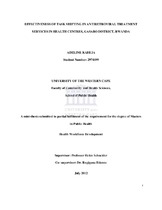| dc.description.abstract | In the context of human resource crisis in African countries, the World Health Organization has proposed task-shifting as an approach to meet the ever-increasing need for HIV/AIDS care and treatment services. Rwanda started the process of task shifting towards nurse-based care in ART services in June 2010. After one year of implementation, a need to determine whether task shifting program has been implemented as intended and if it achieved its primary goal of
increasing accessibility of people living with HIV to ARV therapy and improving nurse capacity in HIV patient care was imperative.A multi-method program evaluation study design, combining cross sectional, retrospective review and retrospective cohort sub-studies were used to evaluate the implementation,maintenance processes and outcomes of task shifting in 13 Health Centres (HCs) located in the catchment area of Kibagabaga District Hospital, in Rwanda. The study population consisted of HCs providing task shifted care (n=13), nurses working in the ART services of the 13 HCs(n=36), and more than 9,000 patients enrolled in ART care in the 13 HCs since 2006. All 13 HCs and 36 nurses were included in the evaluation. Routine data on patients enrolled in the pre-task
shifting period (n=6 876) were compared with the post task shifting period (n=2 159), with a specific focus on data in the 20-months periods prior to and after task shifting. A cohort of patients 15 years and older, initiated onto ART specifically by nurses from June to December 2010 was sampled (n=170) and data extracted from patients medical files.Data collection was guided by a set of selected indicators. Three different data collection tools were used to extract data related to planning, overall programmatic data and individual data from respectively, the program action plans/reports, HIV central databases and patients medical files.
Descriptive analysis was performed using frequencies, means and standard deviations (SD). The paired and un-paired t-tests were used to compare means, and chi-square test was used to compare categorical variables. To compare and to test statistical difference between two repeated measurements on a single sample but with non-normally distributed data, Wilcoxon signed rank test was used. To judge if current task shifted care is better, similar or worse than non-task
shifted care, comparisons were made of program outputs and outcomes from the central database prior to and after the period of task shifting, and also with the cohort of nurse initiated patients.Results showed that 61% of nurses working in the ART program were fully trained and certificated to provide ART. Seven out of 13 HCs met the target of a minimum of 2 nurses trained in ART service delivery. Supervision and mentorship systems for the 13 HCs were well organized on paper, although no evidence documenting visits by mentors from the local district
hospital to clinics was found. In term of accessibility, the mean number of patients newly initiated on ART per month in the HCs increased significantly, from 77.8/month (SD=22.7) to 93.9/month (SD=20.9) (t test (df=38), p=0.025). A small minority of patients was enrolled in late stages of HIV, with only 15% of the patient cohort having CD4 counts of less than 100 cell /μL at initiation on ART. The baseline median CD4 cell count was 267.5 cells /μL in the cohort as a whole. With respect to quality of care, only 8.8% of patients in the cohort had respected all
appointments over a mean follow up period of 17.2 months; and although follow up CD4 counts had been performed on the majority of patients (80%), it was done after a mean of 8.5 months(SD=2.7) on ART, and only a quarter (24.7%) had been tested by 6 months (as stipulated by guidelines). From central ART program data, a small but significant increase of patients on 2nd line drugs was observed after implementation of task shifting (from 1.98% to 3.00%, 2=13.26,p<0.001), although the meaning of this shift is not entirely clear.The median weight gain was 1 kg and median CD4 increase was 89.5 cells /μL in the cohort after 6 months of receiving task shifted care and treatment. These increases were statistically
significant for both male and female patients (Wilcoxon signed rank test, p<0.001). With regard to loss to follow up, only three of the 170 patients in the cohort followed up by nurses had been lost to follow-up after a mean of 17.2 months on treatment. The routine data showed a decrease of patients lost to follow up, from 7.0% in the pre-task shifting period to 2.5% in the post-task shifting period. In general, the mortality rate was slightly lower in the post-task shifting period
than in the pre-task shifting (5.5% vs 6.9% respectively), although this was not statistically significant (2=2.4, df=1, p=0.1209).This study indicates that, after over one year of implementation of task shifting, task shifting enabled the transfer of required capacity to a relatively high number of nurses. In an already well
established programme, task shifting achieved moderate improvements in uptake (access) to ART, significant reductions in loss to follow up, and good clinical outcomes. However,evaluation of process quality highlighted some concerns with respect to adherence to testing guidelines on the part of providers and follow up visits on the part of patients. Improvements in processes of monitoring and follow up are imperative for optimal mid-term and long-term task shifting in the ART program. | en_US |

